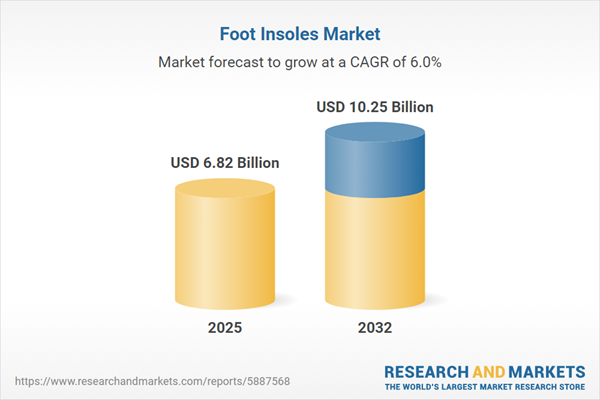Speak directly to the analyst to clarify any post sales queries you may have.
Senior leaders navigating the foot insoles market operate in a dynamic environment shaped by advancing technology, shifting consumer expectations, and regulatory change. Effective market intelligence is vital to guide strategic priorities and sustain competitive positioning in a sector at the confluence of healthcare and lifestyle.
Market Snapshot: Foot Insoles Market Size and Growth Overview
The foot insoles market expanded from USD 6.44 billion in 2024 to USD 6.82 billion in 2025, on track to reach USD 10.25 billion by 2032 with a CAGR of 5.98%. Market progression responds to rising focus on ergonomic excellence, the personalization of health-oriented products, and long-term demographic changes influencing healthcare utilization. Companies have capitalized by using advanced materials and integrating digital innovations, broadening their reach to include both traditional and emerging segments. Preventative care and everyday wellness are increasingly central, positioning foot insoles at the nexus of clinical need and consumer wellbeing. Heightened awareness of personal health and advancing technologies continue to shape overall sector direction.
Scope & Segmentation of the Foot Insoles Market
- Product Types: Foot insoles include custom-made items crafted via methods like 3D printing and vacuum molding, as well as off-the-shelf solutions for widespread consumer and institutional use.
- Material Types: Carbon fiber (multiple weaves), cork (natural and composite forms), a variety of foams including EVA and PU, and gel solutions such as silicone and thermoplastic elastomer are leveraged to address diverse user profiles for comfort and durability.
- Gender Targeting: Engineering accounts for needs of female, male, and unisex users, recognizing distinct ergonomic and aesthetic preferences among populations.
- Distribution Channels: Sales span traditional retail and specialty stores, dedicated direct sales, and digital options including e-commerce and branded websites, adapting to varied buyer journeys.
- End Users: Clinics, hospitals, and private consumers depend on insoles for prevention, therapy, or comfort, each segment valuing different outcome metrics.
- Application Areas: Foot insoles are integrated across daily and formal footwear, industrial safety boots, medical therapy—such as for diabetes care and plantar fasciitis management—and performance wear in athletics including running, football, and walking.
- Regional Coverage: Activity is distributed throughout the Americas, Europe, Middle East and Africa, and Asia-Pacific, with each area shaped by unique drivers, regulation, and consumer attitudes.
- Key Companies Profiled: Major innovators and standard-bearers—Dr. Scholl’s, Superfeet Worldwide, Aetrex Worldwide, SOLE, Powerstep, Spenco Medical, Bauerfeind AG, Vionic Group, Tread Labs, and Footbalance Systems Oy—anchor quality benchmarks and lead channel strategy across markets.
Key Takeaways for Senior Decision-Makers
- Eco-friendly initiatives and investments in technology shape ongoing product development and resource allocation, particularly in digital manufacturing and partnerships driving research and development.
- Cross-functional collaboration is increasing between clinicians, material experts, and manufacturers, a trend intensified by tighter global regulations and evolving compliance requirements.
- Adopting omnichannel distribution, blending online and offline engagement, enhances access for diverse buyers in both institutional and retail channels.
- New technologies—such as 3D scanning for personalized fit and embedded sensor systems—advance product quality, lifecycle monitoring, and help firms differentiate offerings.
- Diverse healthcare policies and region-specific incentives demand tailored go-to-market strategies and regulatory expertise for effective expansion and sustained growth.
Tariff Impact on Market Operations
Recent changes to United States tariffs affecting footwear components have increased supply chain complexity in the foot insoles market. Industry participants are responding through strategic sourcing shifts, greater investment in domestic manufacturing, and deployment of flexible production systems. Building alliances, streamlining operational processes, and proactive participation in regulatory discussions enable businesses to mitigate emerging risks and influence evolving standards.
Methodology & Data Sources
This analysis integrates trade source review, corporate disclosures, evolving regulatory information, and direct interviews with leaders in manufacturing, clinical practice, and distribution. Comprehensive peer review and industry workshops validate findings and ensure practical guidance aligned with current compliance and operational realities in the foot insoles market.
Why This Report Matters
- Delivers actionable segmentation and technology insights for diverse stakeholder needs and regional contexts, equipping decision-makers to align resources with market opportunities.
- Supports strategic initiatives by clarifying regulatory risk, technology trends, and shifts in health and wellness consumer behavior.
- Guides operational planning for resilience and sustainability in procurement and production, relevant for evolving sourcing requirements.
Conclusion
Firms achieving long-term success in the foot insoles market will emphasize innovation, sound segmentation, and strategic agility. Leveraging up-to-date research and proven solutions supports growth, differentiation, and sustainable operations amid continuous industry change.
Additional Product Information:
- Purchase of this report includes 1 year online access with quarterly updates.
- This report can be updated on request. Please contact our Customer Experience team using the Ask a Question widget on our website.
Table of Contents
3. Executive Summary
4. Market Overview
7. Cumulative Impact of Artificial Intelligence 2025
Samples

LOADING...
Companies Mentioned
The key companies profiled in this Foot Insoles market report include:- Dr. Scholl’s, Inc.
- Superfeet Worldwide, Inc.
- Aetrex Worldwide, Inc.
- SOLE, Inc.
- Powerstep, Inc.
- Spenco Medical Corporation
- Bauerfeind AG
- Vionic Group LLC
- Tread Labs, Inc.
- Footbalance Systems Oy
Table Information
| Report Attribute | Details |
|---|---|
| No. of Pages | 180 |
| Published | October 2025 |
| Forecast Period | 2025 - 2032 |
| Estimated Market Value ( USD | $ 6.82 Billion |
| Forecasted Market Value ( USD | $ 10.25 Billion |
| Compound Annual Growth Rate | 5.9% |
| Regions Covered | Global |
| No. of Companies Mentioned | 11 |









